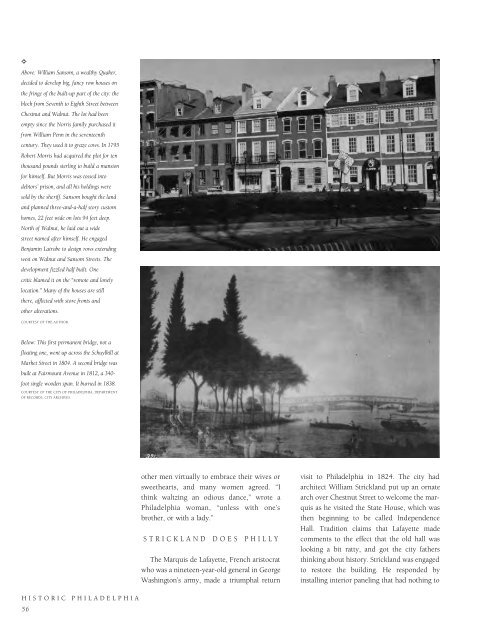Historic Philadelphia
An illustrated history of the city of Philadelphia, paired with the histories of companies, families and organizations that make the region great.
An illustrated history of the city of Philadelphia, paired with the histories of companies, families and organizations that make the region great.
You also want an ePaper? Increase the reach of your titles
YUMPU automatically turns print PDFs into web optimized ePapers that Google loves.
✧<br />
Above: William Sansom, a wealthy Quaker,<br />
decided to develop big, fancy row houses on<br />
the fringe of the built-up part of the city: the<br />
block from Seventh to Eighth Street between<br />
Chestnut and Walnut. The lot had been<br />
empty since the Norris family purchased it<br />
from William Penn in the seventeenth<br />
century. They used it to graze cows. In 1795<br />
Robert Morris had acquired the plot for ten<br />
thousand pounds sterling to build a mansion<br />
for himself. But Morris was tossed into<br />
debtors’ prison, and all his holdings were<br />
sold by the sheriff. Sansom bought the land<br />
and planned three-and-a-half story custom<br />
homes, 22 feet wide on lots 94 feet deep.<br />
North of Walnut, he laid out a wide<br />
street named after himself. He engaged<br />
Benjamin Latrobe to design rows extending<br />
west on Walnut and Sansom Streets. The<br />
development fizzled half built. One<br />
critic blamed it on the “remote and lonely<br />
location.” Many of the houses are still<br />
there, afflicted with store fronts and<br />
other alterations.<br />
COURTESY OF THE AUTHOR.<br />
Below: This first permanent bridge, not a<br />
floating one, went up across the Schuylkill at<br />
Market Street in 1804. A second bridge was<br />
built at Fairmount Avenue in 1812, a 340-<br />
foot single wooden span. It burned in 1838.<br />
COURTESY OF THE CITY OF PHILADELPHIA, DEPARTMENT<br />
OF RECORDS, CITY ARCHIVES.<br />
other men virtually to embrace their wives or<br />
sweethearts, and many women agreed. “I<br />
think waltzing an odious dance,” wrote a<br />
<strong>Philadelphia</strong> woman, “unless with one’s<br />
brother, or with a lady.”<br />
STRICKLAND DOES PHILLY<br />
The Marquis de Lafayette, French aristocrat<br />
who was a nineteen-year-old general in George<br />
Washington’s army, made a triumphal return<br />
visit to <strong>Philadelphia</strong> in 1824. The city had<br />
architect William Strickland put up an ornate<br />
arch over Chestnut Street to welcome the marquis<br />
as he visited the State House, which was<br />
then beginning to be called Independence<br />
Hall. Tradition claims that Lafayette made<br />
comments to the effect that the old hall was<br />
looking a bit ratty, and got the city fathers<br />
thinking about history. Strickland was engaged<br />
to restore the building. He responded by<br />
installing interior paneling that had nothing to<br />
HISTORIC PHILADELPHIA<br />
56
















